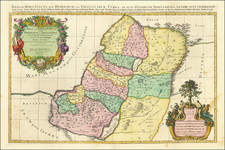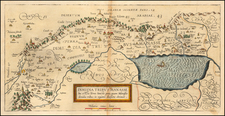The Earliest Representation of the Borders of the Promised Land -- Delineated From Mas-ei
Well executed woodcut map showing the borders of Israel based upon Rashi's interpretation, generally considered to be the earliest known Hebrew map relating to this topic.
The map shows the Land of Israel and surrounding nations, charting the travels of the Children of Israel.The map depicts ships riding the seas with cities delineated by towers adorned with flags in a quite sophisticated manner. The details of the map were entirely based on information derived from the Bible and its commentaries. As E. & G. Wajntraub note in Hebrew Maps of the Holy Land (1992) p. 41 "it was not possible to draw eye-witness reports, and all geographical data is based [only] on the geographical knowledge of the Bible."
This map is from the Leonard and Juliette Rothman collection, and was catalogued as published in Prague in 1609 as part of Levushim, written by Mordechai Jaffe, a ten-volume codification of Jewish law that particularly stressed the customs of the Jews of Eastern Europe. Born in Prague, Joffe was a descendent of Rashi, Hillel and a number of other important Jewish figures in history. However, we note that the map was more likely first included in one of Joffe's 1603 publications.
Rashi, a French Medieval Rabbi (see below) is considered one of the greatest scholars in Jewish history and perhaps the most important. While no original manuscripts of his writings survive, a number were passed down through his students. A few of his texts contain one or more of the following cartographic works:
- schematic maps of the Promised Land’s borders as delineated in theTorah portion of Mas’ei(Numbers33:1–36:13)
- maps of the future tribal allotments as enumeratedi nt he prophecy o fEzekiel
- ageographic sketc hpertaining to the final chapter of th eBook of Judges
- a geographic diagram of the strip of land between Acre and Achzib
Rashi
Shlomo Yitzchaki (1040 – 1105), better known in modern times as Rashi, was a medieval French rabbi from Troyes. Rashi wrote an important early commentary on the Talmud and the Hebrew Bible (Tanakh).
Rashi's work is highly regarded for presenting Biblical and Talmudic text in clear and concise terms, making him both appealling to both scholars and accessible to novic learners. His writings are a centerpiece of contemporary Jewish study. Rashi's commentary on the Talmud, covering virtually the entire Babylonian Talmud (he died before completing the entire Talmud), has been a staple in Talmudic teaching since its first printing by Daniel Bomberg in the 1520s. His commentary on Tanakh is also highly influential.
Rashi was also one of the first authors to write in Old French, making his work useful for modern day study of the language and culture of Northern France in the 11th century.









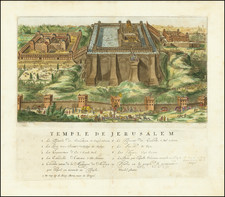
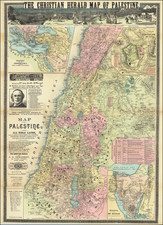
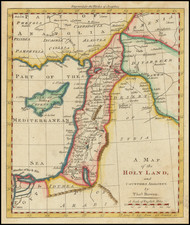
![[Israeli Six-Sheet Map of Israel]](https://storage.googleapis.com/raremaps/img/small/67584.jpg)
